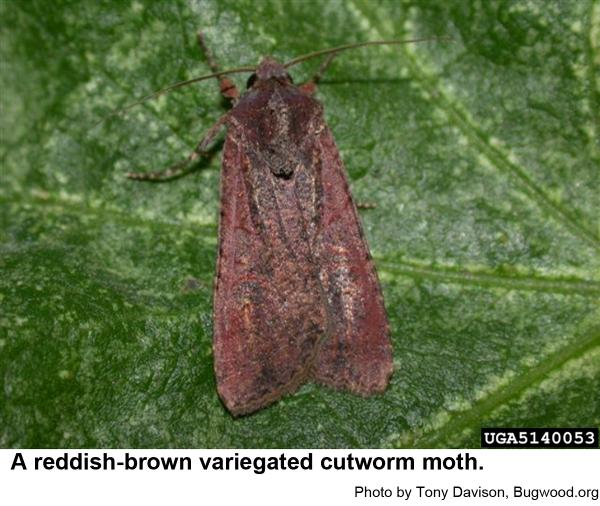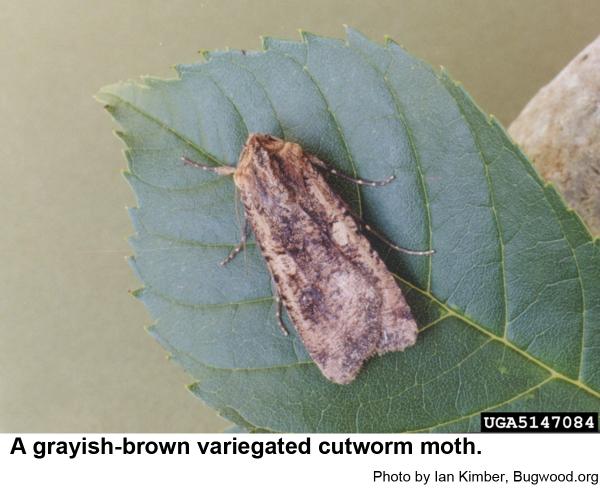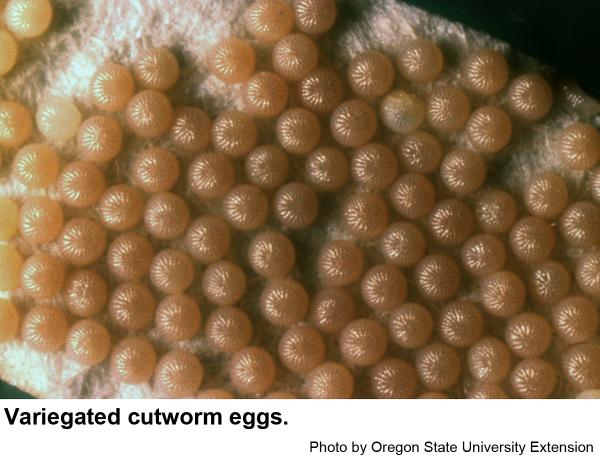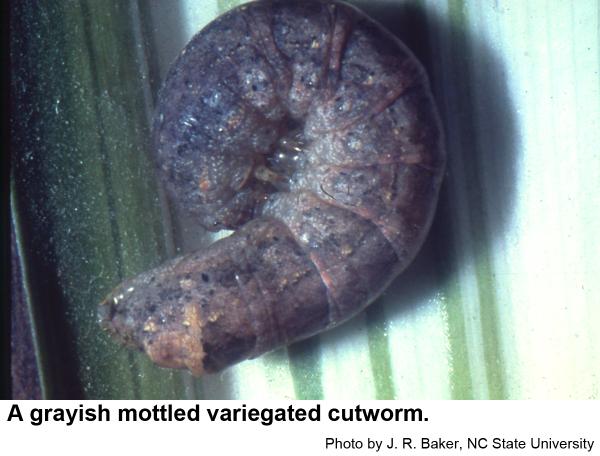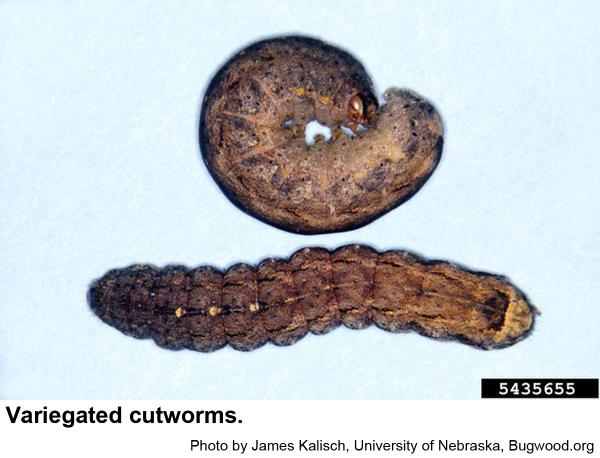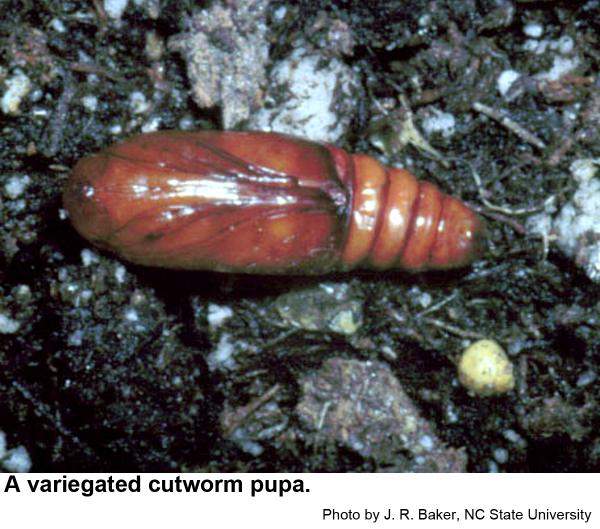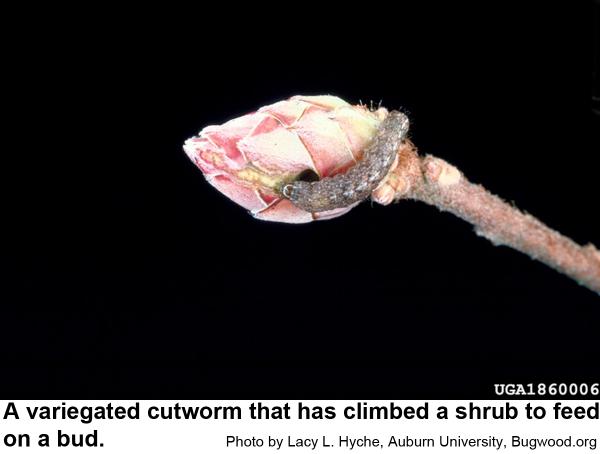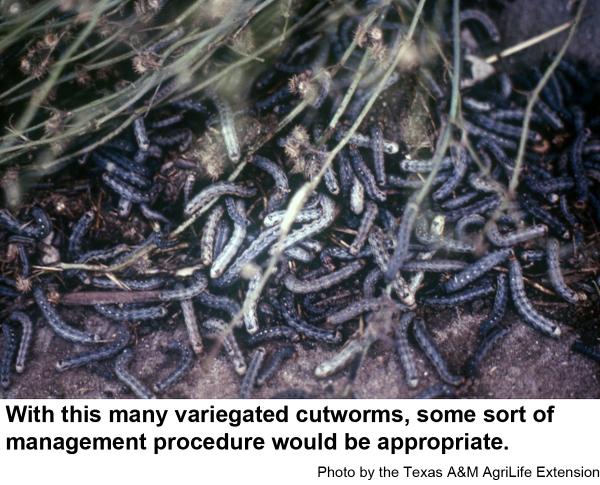Description and Biology
The variegated cutworm, Peridroma saucia, is the immature stage of the pearly underwing moth. These moths have dark, mottled, reddish brown to grayish mottled wings. Their wingspans vary from 13/4 to 2 inches. The hind wings are pale but gradually darken at the edges and are considered "pearly." At night, each female lays dozens of eggs (up to 360 or even 500!) in a mass on stems and foliage. The eggs are tiny, round, and white when first laid but darken before the tiny caterpillars hatch three to five days later. The newly hatched caterpillars are tiny and consume very small amounts of foliage. As they molt and grow each stage consumes an exponential greater amount of foliage. Mature caterpillars appear bare, are usually fat, and are smooth, dull, and mottled. Some have four to six or seven pale spots down the middle of the back. They grow to about 11/2 to 2 inches long, and they curl up when disturbed. Variegated cutworms feed for three to four weeks usually by cutting young plants at the soil line at night and feeding on wilted foliage, which they sometimes drag into a shelter. These cutworms are active at night and usually hide during the day. When mature, variegated cutworms burrow into the soil to pupate. Pupae are brown and spindle shaped and 5/8 to 7/8 inch long. Two (during the summer) to nine weeks later (cool weather in the fall slows development) new moths emerge to mate, lay eggs, and continue their wheel of existence. They overwinter in soil as mature caterpillars or pupae. We have three to four generations per year in North Carolina.
Host Plants
Variegated cutworms are pests of a wide variety of ornamental plants including aster, carnation, chrysanthemum, dahlia, gladiolus, marigold, nasturtium, pansy, petunia, rose, violet, and zinnia. They are pests of vegetable, fruit, and field crops as well. Variegated cutworms often cut young plants near the soil line and feed on wilted foliage. When plants are too large to cut, they climb and feed on foliage, buds, flowers, and even bore into fruits.
Residential Recommendations
Removal of debris should expose the cutworms to predators and parasites. Because variegated cutworms have diverse host plants including many weed species that are never sprayed with insecticides, this species is susceptible to most insecticides available in the garden section of most big box stores, nurseries and other plant centers.
Other Resources
- Cutworm, Variegated. Anonymous. 2013. (update). UMass Extension, Vegetable Program.
- Variegated Cutworm. Anonymous. No Date. PestWeb by UNIVAR, Pest Information.
- Variegated Cutworm, Lepidoptera: Noctuidae, Peridroma saucia. Berry, R. E. 1998. Insects and Mites of Economic Importance in the Northwest. 2nd Ed. 221 pp.
- Insect and Related Pests of Flowers and Foliage Plants. Baker, J. R. ed. 1994 (revised). N.C. Cooperative Extension publication AG-136. 106 pp.
- Insect and Related Pests of Vegetables. Sorensen, K. A. and J. R. Baker eds. 1994. N.C. Cooperative Extension publication AG-295. 180 pp.
- NC State Extension Plant Pathology Publications
- NC State Horticultural Science Publications
- North Carolina Agricultural Chemicals Manual
For assistance with a specific problem, contact your local N.C. Cooperative Extension center.
This factsheet has not been peer reviewed.
Publication date: Feb. 26, 2019
Reviewed/Revised: Dec. 20, 2023
Recommendations for the use of agricultural chemicals are included in this publication as a convenience to the reader. The use of brand names and any mention or listing of commercial products or services in this publication does not imply endorsement by NC State University or N.C. A&T State University nor discrimination against similar products or services not mentioned. Individuals who use agricultural chemicals are responsible for ensuring that the intended use complies with current regulations and conforms to the product label. Be sure to obtain current information about usage regulations and examine a current product label before applying any chemical. For assistance, contact your local N.C. Cooperative Extension county center.
N.C. Cooperative Extension prohibits discrimination and harassment regardless of age, color, disability, family and marital status, gender identity, national origin, political beliefs, race, religion, sex (including pregnancy), sexual orientation and veteran status.

